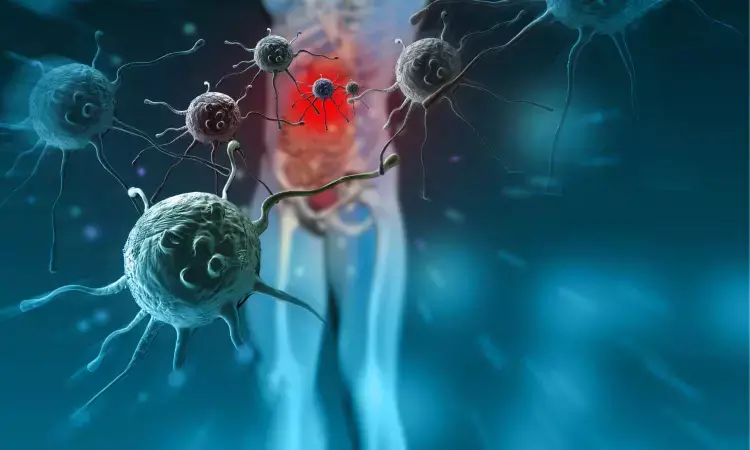- Home
- Medical news & Guidelines
- Anesthesiology
- Cardiology and CTVS
- Critical Care
- Dentistry
- Dermatology
- Diabetes and Endocrinology
- ENT
- Gastroenterology
- Medicine
- Nephrology
- Neurology
- Obstretics-Gynaecology
- Oncology
- Ophthalmology
- Orthopaedics
- Pediatrics-Neonatology
- Psychiatry
- Pulmonology
- Radiology
- Surgery
- Urology
- Laboratory Medicine
- Diet
- Nursing
- Paramedical
- Physiotherapy
- Health news
- Fact Check
- Bone Health Fact Check
- Brain Health Fact Check
- Cancer Related Fact Check
- Child Care Fact Check
- Dental and oral health fact check
- Diabetes and metabolic health fact check
- Diet and Nutrition Fact Check
- Eye and ENT Care Fact Check
- Fitness fact check
- Gut health fact check
- Heart health fact check
- Kidney health fact check
- Medical education fact check
- Men's health fact check
- Respiratory fact check
- Skin and hair care fact check
- Vaccine and Immunization fact check
- Women's health fact check
- AYUSH
- State News
- Andaman and Nicobar Islands
- Andhra Pradesh
- Arunachal Pradesh
- Assam
- Bihar
- Chandigarh
- Chattisgarh
- Dadra and Nagar Haveli
- Daman and Diu
- Delhi
- Goa
- Gujarat
- Haryana
- Himachal Pradesh
- Jammu & Kashmir
- Jharkhand
- Karnataka
- Kerala
- Ladakh
- Lakshadweep
- Madhya Pradesh
- Maharashtra
- Manipur
- Meghalaya
- Mizoram
- Nagaland
- Odisha
- Puducherry
- Punjab
- Rajasthan
- Sikkim
- Tamil Nadu
- Telangana
- Tripura
- Uttar Pradesh
- Uttrakhand
- West Bengal
- Medical Education
- Industry
New Standard for Graft-Versus-Host Disease Prevention After Stem Cell Transplant less toxic

Clinicians have a new standard for graft-versus-host disease (GVHD) prevention after allogeneic hematopoietic stem cell transplantation, according to results from a phase III study published June 22 in the New England Journal of Medicine. The new standard is more effective at preventing GVHD and came with less side effects, compared with the current gold standard.
“The new standard allows transplants to be less toxic,” says lead study author Javier Bolaños-Meade, M.D., professor of oncology at the Johns Hopkins Kimmel Cancer Center.
In an allogeneic bone marrow transplant, the healthy stem cells come from the bone marrow of a relative who is not an identical twin of the patient or from an unrelated donor who is genetically similar to the patient. But a bone marrow transplant can cause GVHD, a serious and life-threatening complication. For decades, researchers in the bone marrow transplant community have been interested in decreasing the rates of GVHD, which occurs when the donor's immune system reacts against the recipient's tissue. As opposed to an organ transplant where the patient's immune system will attempt to reject only the transplanted organ, in GVHD the new or transplanted immune system can attack the entire patient and all organs.
“At Hopkins we have been studying better alternatives to decrease GVHD,” says Bolaños-Meade. “Since the late 1990s, early 2000s, we at Hopkins have been studying the role of a high-dose, post-transplantation, cyclophosphamide-based platform.”
The current gold standard to prevent GVHD after bone marrow transplants is a combination of two drugs: a calcineurin inhibitor, such as tacrolimus or cyclosporine, and methotrexate. In the current phase III study, researchers from multiple institutions tested this standard to prevent GVHD against an experimental regimen of three drugs: cyclophosphamide, tacrolimus, and mycophenolate mofetil. Patients were recruited and randomized to either arm. This was done during the COVID-19 pandemic, but despite that, the study completed accrual ahead of time: 431 patients were enrolled from 37 centers across the United States. Patients were HLA matched to donors if related, and if unrelated, they were to be matched but could have one antigen mismatch. It took two years to enroll all patients (6/19 to 6/21) and patients were followed for at least one year.
Patients achieved the primary endpoint if they were alive, without acute GVHD grade III-IV, without chronic GVHD needing immunosuppression, and without relapse or progression from their cancer. At one year, the probability of achieving the endpoint was 52.7% for those getting the cyclophosphamide platform compared with 34.9% for those getting methotrexate and tacrolimus.
“More than half patients in the cyclophosphamide platform were alive, free of grade III-IV acute GVHD and chronic GVHD needing immunosuppression, and without disease relapse or progression versus a third in the methotrexate and tacrolimus arm,” says Bolaños-Meade. “There were also a series of secondary endpoints showing less severe acute GVHD, and less chronic GVHD. Very importantly this was seen without an increase on relapses as historically — the better control of GVHD, the more cancer relapses. In this case we have better control of GVHD, but no more relapses.”
The researchers say that for the first time since the 1980s, we have a more effective drug therapy to prevent severe cases of GVHD, and therefore, we have a new standard of care. “This is important because methotrexate and tacrolimus is toxic enough. Now our transplants can be performed even in older individuals. In fact, the median age in the study was 66 years,” says Bolaños-Meade.
Reference:
Javier Bolaños-Meade, Mehdi Hamadani, Juan Wu, Monzr M. Al Malki, Michael J. Martens, Lyndsey Runaas, Hany Elmariah, Andrew R. Rezvani, Mahasweta Gooptu, Karilyn T. Larkin, Brian C. Shaffer, Najla El Jurdi, DOI: 10.1056/NEJMoa2215943.
Dr Kamal Kant Kohli-MBBS, DTCD- a chest specialist with more than 30 years of practice and a flair for writing clinical articles, Dr Kamal Kant Kohli joined Medical Dialogues as a Chief Editor of Medical News. Besides writing articles, as an editor, he proofreads and verifies all the medical content published on Medical Dialogues including those coming from journals, studies,medical conferences,guidelines etc. Email: drkohli@medicaldialogues.in. Contact no. 011-43720751


